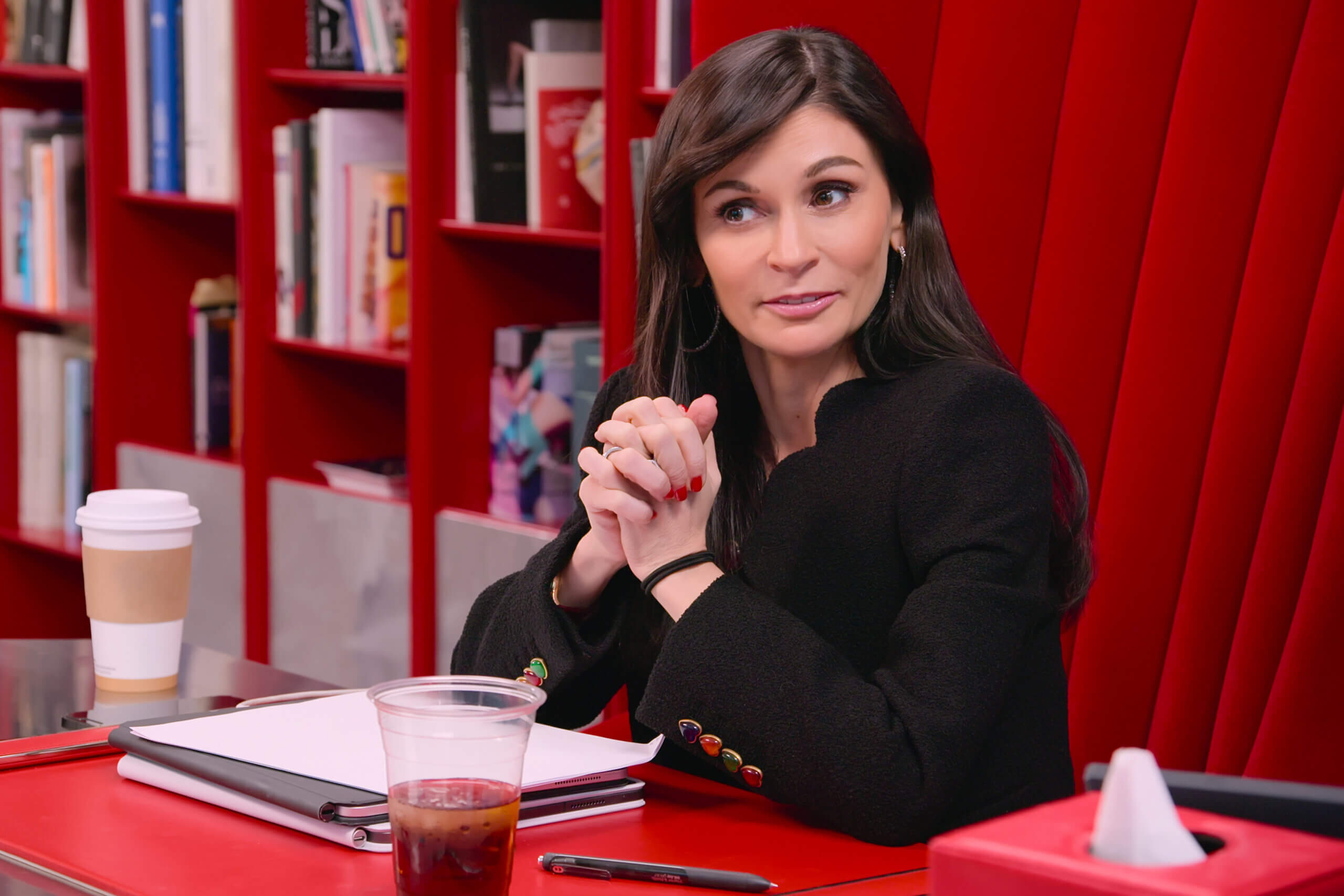They hate to see a girlboss getting divorced: ‘My Unorthodox Life’ is back
In the Netflix reality show’s second season, formerly Haredi fashion mogul Julia Haart finds that her divorce threatens her image as a powerful professional woman

Julia Haart with her daughters Batsheva, left, and Miriam, right. Courtesy of Netflix
Everyone knows the girlboss era is over.
For almost a decade, the term denoted admiration for a woman who, through grit and determination, achieves the kind of powerful career historically reserved for men. But millennials have become disillusioned with Lean In-style dogmas that feel increasingly out of reach in our vastly unequal society. And stories of mismanagement and abuse at female-led companies have challenged the notion that women are inherently enlightened or progressive leaders.
In recent years, zeal for the girlboss has curdled into disdain. The girlboss has been eulogized in the press. She’s been pilloried in memes. On social media, the slogan “gaslight, girlboss, gatekeep” has become shorthand for a woman who seeks to ascend the ranks of a broken system rather than to change it.
Those trumpeting the death of the girlboss appear not to have watched the confused meditation on female empowerment that is the Netflix reality show My Unorthodox Life. Nor does the show’s star, Julia Haart, seem aware of this archetype’s newly ignominious status. A formerly Haredi rebbetzin (rabbi’s wife) who left her community to become a fashion mogul in the secular world, Haart has positioned her transformation from repressed housewife to leather-clad, latte-sipping executive as the core of her brand.
But in the show’s second season, fissures in that narrative start to appear. When Haart divorces her billionaire husband, Silvio Scaglia, she experiences a reversal of fortune that shouldn’t be possible for a woman who has it all — and, if inadvertently, exposes the problems with the girlboss version of female liberation.
For those who choose to remain blissfully ignorant of Netflix’s incursions into reality TV, a little background: Hailing from Monsey, New York, Haart married and raised four children within a Haredi community she described as repressive and patriarchal. (Her characterizations of Monsey on My Unorthodox Life raised ire among some Haredi women, who used the briefly viral hashtag #myorthodoxlife to share stories of happiness and fulfillment within their communities.) In 2013, she got divorced and set out to try her luck in the fashion industry.
Just a few years after entering the secular world, Haart appeared to have achieved astounding success: She launched a line of shoes, designed a Met Gala dress for Kendall Jenner and, a few months before marrying Scaglia, become CEO and co-owner of Elite World Group, a modeling agency her husband had purchased several years earlier. Haart’s three adult children — Batsheva, an influencer, Shlomo, a shy student, and Miriam, a precocious coder — joined her in the marital penthouse and play prominent roles in My Unorthodox Life. (She and her first husband share custody of their youngest son, Aron, who remains involved in the Haredi world and appears intermittently on the show.)

The first season of My Unorthodox Life focused on Haart’s exodus from Monsey, presenting her as an entirely self-made woman and attributing her success to her creative talent and ability to hustle. Scaglia, who made brief appearances to kiss Haart’s hand and call her “my love,” always seemed more like a posh-accented accessory than an actual spouse, and the couple’s divorce was extremely predictable.
What’s surprising is Scaglia’s power to upend his ex-wife’s life.
In Haart’s telling, she and Scaglia agreed to divorce without changing their professional relationship or their respective roles at Elite World Group. By the second episode, however, Scaglia has begun to assert total control over assets Haart considers jointly owned. In one surprisingly candid scene, Haart and her entourage are blindsided by an abrupt email announcing that the board has replaced her as CEO.
Scaglia subsequently asserts in lawsuits that he is the sole owner of the agency, and accuses Haart of such colorful improprieties as using company funds to pay for breast implants. He threatens to come to the aforementioned penthouse with movers to take away all the furniture; when Haart finds out that her former chef has snuck in during the night and stolen a piece of art, she concludes that Scaglia has paid him to do so.
Despite surrounding herself with the trappings of girlbossery, Haart isn’t living up to the untouchable persona she’s created. And there’s nothing inherently wrong with that. Perhaps because she left an insular community with few resources, perhaps because she worked in a sexist environment, perhaps because, as Scaglia’s allies have suggested, she’s just not a great leader, Haart ended up reliant on a man even as she made total independence her personal brand. As we reexamine the girlboss ideal, stories like hers, about women for whom sheer grit and independence do not yield empowered and fabulous lives, feel newly compelling.
But while Haart loves to kvetch about the time spent corresponding with her lawyers and make grave references to legal entities like the Chancery Court of Delaware, My Unorthodox Life does everything to avoid addressing the gap between her persona and her reality. The show can’t delve too deeply into the court documents, because to do so would inevitably produce a portrait of a flawed woman, not a tale of uncompromised empowerment. Instead, Haart clings to a personal narrative that increasingly seems like a myth. Again and again, she insists that Scaglia is spewing lies and that, despite the fact that the Chancery Court of Delaware repeatedly sides with him, she will eventually prove her point.

As if to compensate for its obfuscation on the most interesting points, My Unorthodox Life devotes far too much airtime to various prurient or simply banal subplots. Shlomo halfheartedly attempts to lose his virginity. Robert, Haart’s closest friend and colleague (until Scaglia ousts them both) and his boyfriend Ra’ed have important conversations about their open relationship while shaving each other’s backs. Batsheva, recently divorced herself, is dating furiously — but also has to take Haart to therapy after she repeatedly overshares about her daughter’s sex life.
(Just a few weeks ago I wrote of Hulu’s new series Fleishman is in Trouble that “sex has never seemed worse or less appealing;” I regret to report that My Unorthodox Life is already compelling me to eat my words.)
Several of the show’s subplots feature Haart fighting for, in her own words, “freedom for as many women as humanly possible.” (It should be noted that she makes this comment in reference to helping a model develop a lucrative Instagram presence.) In one, Haart collaborates with Amber Adler, an Orthodox activist and candidate for New York City Council, to plan a safehouse for Jewish and non-Jewish women leaving abusive marriages. By supporting this cause, Haart can bolster her self-image as a benefactor, a woman who can give aid rather than receiving it.
In her own story, those demarcations — between freedom and dependence, success and defeat — are rarely so clear. Failure to conform to a chosen ideal of womanhood is the one thing that connects Haart’s improbable, gilded life to those of the women who might watch My Unorthodox Life. Yet for Haart, that failure is nothing more than a source of shame. Rather than address the contradictions that make her life interesting, the show simply retreats into pantsuit-shaped stereotypes.






















